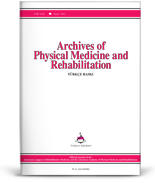Juhakoski R, Tenhonen S, Anttonen T, Kauppinen T, Arokoski JP. Kalça osteoartritli hastalarda kendisince-bildirilen ağrı ve fiziksel fonksiyonu etkileyen faktörler. Arch Phys Med Rehabil 2008;89:1066-73. Amaç: Kalça osteoartriti (OA) olan hastalarda kendisince-bildirilen ağrı ve fiziksel fonksiyon ile ilişkili faktörleri belirlemek. Tasarım: Kesitsel çalışma. Merkez: Finlandiya'daki bir hastanede rehabilitasyon kliniği. Katılımcılar: Kalça OA olan katılımcılar (N=118; 35 erkek, 83 kadın; yaş 66.7±6.5 yıl; yaş aralığı 55-80 yıl) Girişimler: Uygulanabilir değil. Temel Sonuç Ölçütleri: Western Ontario McMaster Universities Osteoarthritis Index kullanılarak kendisince-bildirilen ağrı ve kendisince-bildirilen hastalığa-özgü fiziksel fonksiyonlar kaydedildi. Kendisince-bildirilen soysal fiziksel fonksiyon RAND 36 Maddelik Kısa Form Sağlık İncelemesi'nin Finversiyonu kullanılarak analiz edildi. Fonksiyon, Sakatlık ve Sağlık Uluslararası Sınıflaması modelinde listelendiği gibi, kişisel faktörlerin (yaş, cinsiyet, eğitim, depresyon, yaşam memnuniyeti, sigara içme, spor aktivitelerinin yılları), patofizyolojik faktörler (kalça OA'nin radyolojik skoru, beden kitle indeksi[BKİ], eşlik eden hastalıklar, diz ağrısının süresi) ve vücut fonksiyonları ile yapılarının (bacak ekstansör gücünün ölçümü, kalça ekleminin pasif iç rotasyonu ve fleksiyonu, altı-dakika yürüme testi [6DYT], Timed Up & Go[TUG] testi, on-metre yürüme testi, çorap testi) etkisi analiz edildi. Bulgular: Kendisince-bildirilen hastalığa-özgü fiziksel fonksiyon için eğitim seviyesi (r=0.264, p<0.001), eşlik eden hastalıklar (r=0.313, p<0.001), BKİ (r=0.252, p<0.001)'nin yanısıra yine kendisince-bildirilen soysal fiziksel fonksiyon için eğitim seviyesi (r=0.319, p<0.001), yaşam memnuniyeti (r=0.319, p<0.001), BKİ (r=0.290, p<0.001) ve eşlik eden hastalıklar (r=0.220, p<0.005) anlamlı faktörler olarak belirlendi.Ağrı ile psikolojik faktörler arasında doğrudan ilişki saptanmadı. Eşlik eden hastalıklar ve diz ağrısının süresi ve yaşam memnuniyeti kendisince-bildirilen ağrının %22'sini açıklıyordu. Pasif kalça fleksiyonu, 6DYT ve eğitim seviyesi kendisince-bildirilen soysal fiziksel fonksiyonun %25'ini açıklarken, eşlik eden hastalıklar, pasif kalça fleksiyonu ile TUG testi, kendisince-bildirilen hastalığa-özgü fiziksel fonksiyonun %20'sine açıklık getirebildi. Sonuçlar: Eğitim seviyesi, yaşam memnuniyeti ve eşlik eden hastalıkların sayısı kalça OA'ndeki kendisince-bildirilen ağrı ve fiziksel fonksiyonun her ikisi için önemli faktörler olarak belirlendi. Performans ölçümleri kalça OA'nde ağrıdan daha çok fiziksel fonksiyonun göstergesidir. Kalça OA'nde sakatlık ve ağrıyı açıklayan faktörler çok boyutludur ve tek bir göstergenin diğerlerine üstün olduğu bulunamamıştır.
Anahtar Kelimeler: Osteoartrit, kalça; Ağrı; Rehabilitasyon.
Juhakoski R, Tenhonen S, Anttonen T, Kauppinen T, Arokoski JP. Factors affecting self-reported pain and physical function in patients with hip osteoarthritis. Arch Phys Med Rehabil 2008;89:1066-73. Objective: To determine the factors associated with selfreported pain and physical function in patients with hip osteoarthritis (OA). Design: Cross-sectional study. Setting: Rehabilitation clinic in a Finnish hospital. Participants: Participants with hip OA (N118; 35 men, 83 women; age, 66.76.5y; range, 55-80y). Interventions: Not applicable. Main Outcome Measures: Self-reported pain and self-reported disease-specific physical function were recorded by using the Western Ontario McMaster Universities Osteoarthritis Index. Self-reported generic physical function was analyzed by using the Finnish version of the RAND 36-Item Short-Form Health Survey. As listed in the International Classification of Functioning, Disability and Health model, the effects of personal factors (age, sex, education, depression, life satisfaction, smoking, years of sporting activities), pathophysiologic factors (radiologic score of hip OA, body mass index [BMI], comorbidities, duration of knee pain) and body functions and structures (measurement of leg extensor power, passive internal rotation and flexion of the hip joint, the six-minute walk test [6MWT], Timed Up & Go [TUG] test, ten-meter walk test, sock test) were analyzed. Results: The educational level (r.264, P.001), comorbidities (r.313, P.001), and BMI (r.252, P.001) were identified as significant factors for self-reported disease-specific physical function as well as the educational level (r.291, P.001), life-satisfaction (r.319, P.001), BMI (r.290, P.001), and comorbidities (r.220, P.005) for the self-reported generic physical function. No direct relationship with the pain and psychologic factors was detected. The number of comorbidities and duration of knee pain and life satisfaction explained 22% of self-reported pain. The number of comorbidities, passive hip flexion, and the TUG test explained 20% of self-reported disease-specific physical function whereas the passive hip flexion, 6MWT, and educational level explained 25% of self-reported generic physical function. Conclusions: Educational level, life satisfaction, and number of comorbidities were identified as significant factors for both self-reported pain and physical functioning in hip OA. Performance measures are better predictors of physical function than pain in hip OA. Factors explaining disability and pain in hip OA are multidimensional and no single predicting factor was found to be superior to any other.
Keywords: Osteoarthritis, hip; Pain; Rehabilitation.







.: Process List